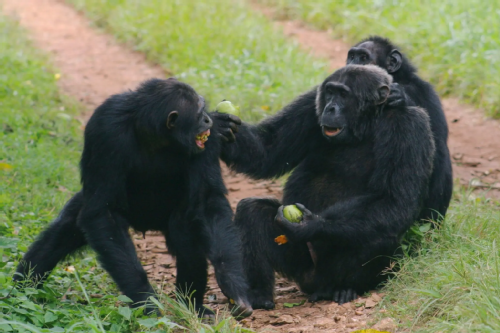Press Releases
Chimpanzee see, chimpanzee know: Apes understand reasons behind each other’s actions, says new University of Warwick research
A research team, including academics from The University of Warwick, has suggested that apes can understand the communicative goals behind each other’s actions – a skill previously thought to be unique to humans.
Ever since Jane Goodall first observed apes gesturing to each other in the 1960s, researchers have debated how great apes like chimpanzees and gorillas communicate. The new research argues that apes use body language to show each other their communicative intentions.
The new research argues that apes use body language to show each other their communicative intentions.
Apes understand what different parts of their bodies are used for. As a result, they can recruit these different body parts to use as gestures for communicative purposes.
So, if a baby chimp has its arms outstretched towards its mother’s back, the mother can understand it wants carrying, as she knows she uses her back to carry.
This new ‘Recruitment view’ of great ape gestures aims to replace two historically influential views. One idea, the ‘Leipzig View’, suggests that apes learn gestures through repeated interactions, leading to differences between groups. Another theory, the ‘St Andrews View’, argues that these gestures are universal across all great apes, meaning they don't need to be learned.
Now, a team including Dr Richard Moore at Warwick, has proposed a fresh perspective. Their view suggests that apes use parts of their bodies or familiar actions to communicate.
These gestures aren't taught or inherited; they arise naturally because all great apes have similar bodies and engage in similar activities.
Dr Moore, Associate Professor at The University of Warwick, explained: “Imagine a chimpanzee showing another chimp its shoulder to be groomed, or making a motion like beckoning it to move closer.
“These aren’t random gestures – they’re using what they already know about their bodies to get a message across.”
However, unlike humans, apes rely heavily on clear physical cues, such as body movements or gestures, to interpret these intentions.
“This theory offers a new perspective on how human language might have evolved,” Dr Moore said. “We see a link between the gestures apes use and the early forms of communication that may have eventually developed into human language.
“While this highlights a new continuity in understanding language evolution, we also emphasise the key difference: humans can convey complex ideas without needing such obvious physical cues.”
Researchers have compared it to a human showing someone their black eye to show that they have had a bad day.
The team’s theory also addresses a question that has puzzled scientists for years: Why do apes across different species and groups use such similar gestures?
The answer, they suggest, lies in the shared actions and body parts that all apes have, making these gestures easily understood across species.
The full paper can be read here.
Notes to Editors
The findings of this research have been published in the latest issue of Biological Reviews, co-authored by Dr. Kirsty E. Graham, Dr. Federico Rossano, and Dr. Richard T. Moore.
Image credit: Cat Hobaiter
